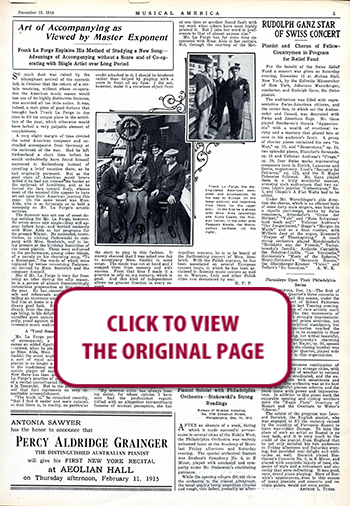 100 YEARS AGO...IN MUSICAL AMERICA (74)
100 YEARS AGO...IN MUSICAL AMERICA (74)
December 19, 1914
Page 5
Art of Accompanying as Viewed by Master Exponent
Frank La Forge Explains His Method of Studying a New Song—Advantage of Accompanying without a Score and of Co-operating with Single Artist over Long
SO much dust was raised by the triumphant arrival of the operatic folk in October that the return of a certain musician, without whose co-operation the American music season would lose one of its highly distinctive features, was accorded all too little notice. It was, indeed, a rare piece of good fortune that brought back Frank La Forge in due time to fill his unique place in the activities of the year, which otherwise would have lacked a very palpable element of completeness.
A very slight margin of time divided the noted American composer and unrivalled accompanist from Germany at the outbreak of the war. Had he left Switzerland a short time before he would undoubtedly have found himself marooned in Rothenburg instead of spending a brief vacation there, as he had originally purposed. But as the good stars of American music lovers willed it he had not crossed the border at the outbreak of hostilities, and so he turned his face toward Italy, whence most of the musical elite appear to have set out upon their American journey this year. On the same vessel was Mme. Aida, who is so fortunate as to hold a monopoly on Mr. La Forge’s artistic services.
The Summer was not one of sweet doing nothing for Mr. La Forge, however. He wrote seven new songs—they will appear before long—and worked zealously with Mme. Aida on her programs for the present Winter. He succeeded, nevertheless, in visiting Paderewski in company with Mme. Sembrich, and in being present at the birthday festivities of the noted pianist. These were enlivened by the performance, among other things, of a parody on his charming song, “To a Messenger,” the words of which were replaced by verses concerning Paderewski devised by Mme. Sembrich and the composer himself.
But if Mr. La Forge is very far from being an idler during the silly season, he is a person of almost disconcertingly industrious propensities at this time of the year. He has concerts and rehearsals and rehearsals and concerts, entailing an enormous amount of labor. To find him at home is a stroke of extraordinary good luck. Even more extraordinary, from the standpoint of the average being, is his delightful affability and unruffled good nature, which is, apparently, proof against the ordeal of almost incessant music making.
A “Vocal Sonata” Recital
Mr. La Forge performing the office of accompanist, a song recital assumes an added dignity and high beauty—indeed, when he plays for such artists as Mme. Aida, Mme. Sembrich or Mme Gadski the event might be construed as a sort of vocal sonata recital. The pianist is no longer a mere accompanist in the traditional sense—he is an ensemble player of superlative qualities. Now there has been much ado over Mr. La Forge’s practice of playing his share of a recital un-confronted by a score quite à la Toscanini. But to the pianist himself that fact represents no very remarkable accomplishment.
“The truth is,” he remarked recently, “that I find it easier and more natural, so that there is, in reality, no particular credit attached to it. I should be hindered rather than helped by playing with a score in front of my face. I did not, however, make it a conscious object from the start to play in this fashion. It merely chanced that I was asked one day to accompany Mme. Gadski in some songs. The music was not at hand and I essayed them from memory and with success. From that time I made it a practice to rely on my memory, which is good. And this kind of independence allows me greater freedom in every respect.
“My study of a new song is accomplished away from the piano. The outlines, the musical details and other characteristics of the piece suggest themselves and are mentally absorbed in the process of reading over the score. After that the song is gone over with the artist and we decide upon various matters of interpretation. This is a phase of never-failing interest, particularly as one great singer is apt to differ so materially in her ideas of tempo, or even more subtle matters, from another.
Accompanying a Single Artist
“To me it has been an unmitigated pleasure to be associated with a single artist for long periods. That is the way, it seems to me, to achieve results of an artistic unity and cohesiveness quite unattainable under conditions compelling the accompanist to play for one person to-day and another to-morrow. It permits the development of freedom and individuality, all of which are supremely essential to the modern accompanist.
“My severest critic has always been my sister, for whose opinion I have ever had the profoundest regard. Gifted with an altogether extraordinary fineness of musical perception, she has at one time or another found fault with my work when others have most highly praised it. But I take her word in preference to that of almost anyone else.”
Mr. La Forge has for some time cooperated with Mme. Aida in her recitals. But, through the courtesy of the Metropolitan soprano, he is to be heard at the forthcoming concert of Mme. Sembrich. With the Polish soprano, he has been associated on several European concert tours, in which he has been acclaimed in Russian music centers as well as in Warsaw, Lodz and other Polish cities now devastated by war. —H.F.P




 RENT A PHOTO
RENT A PHOTO





